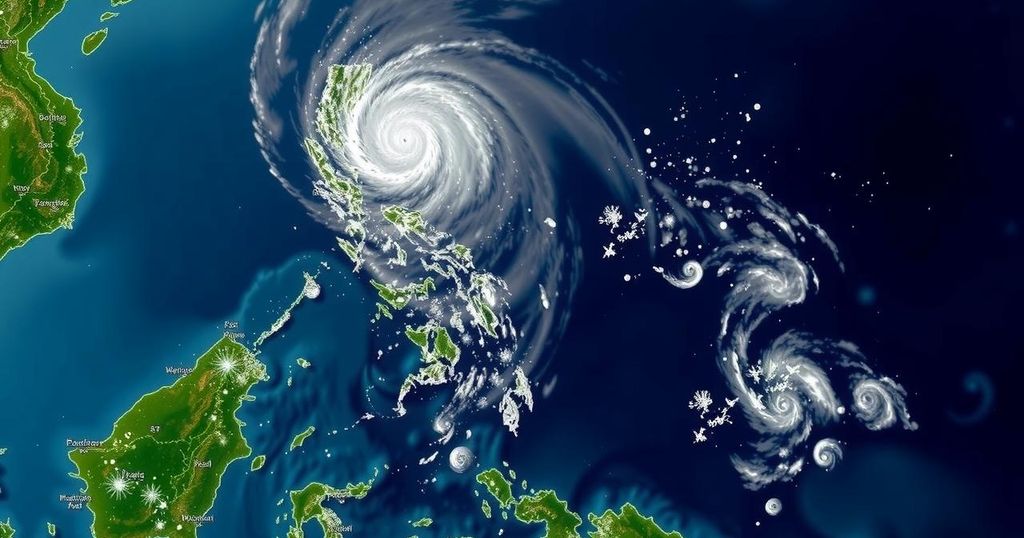Destruction from Tropical Storm Trami: An Urgent Call for Preparedness and Response
Tropical storm Trami has left at least 46 individuals dead in the northwestern Philippines due to severe flooding, prompting urgent rescue efforts. Forecasters warn that the storm may reverse direction and return next week. Over 2.6 million people are affected, with significant displacement. Authorities are contemplating the storm’s trajectory, aiming for effective disaster management.
Tropical storm Trami has recently moved away from the northwestern Philippines, resulting in a tragic death toll of at least 46 individuals, primarily due to severe flooding. Authorities are currently intensifying their efforts to locate and rescue thousands of people trapped by the rising waters, some of whom have sought refuge on rooftops. Despite Trami’s relocation, meteorologists express concern that the storm may reverse course and return to the Philippines in the coming days due to atmospheric pressures in the South China Sea. As of Friday morning, the storm was located approximately 125 kilometers (78 miles) west of Bacnotan in La Union province, maintaining sustained winds of 95 kilometers (59 miles) per hour, with gusts reaching 115 kilometers (78 miles) per hour. It is presently advancing northwest at a speed of 25 kilometers (15 miles) per hour towards Vietnam, which is expected to experience the storm’s effects if it remains on its current trajectory. Philippine President Ferdinand Marcos convened an emergency meeting with his Cabinet to discuss the situation, expressing frustration regarding the storm’s potential return. He questioned whether there was a possibility of a U-turn, emphasizing the significance of the ongoing rain induced by Trami even if it bypasses landfall. “It does not have to make landfall for the damage to occur,” President Marcos stated, highlighting the ongoing impact of the storm’s rains. The government forecaster indicated that while a U-turn is plausible early next week, it is more likely that Trami will continue its path away from the Philippines without causing further direct damage. However, President Marcos also acknowledged another impending storm forming in the Pacific that could pose a further threat to the nation, remarking, “Oh God, it is what it is. We just have to deal with it.” In response to Trami’s devastation, disaster-mitigation officials report that over 2.6 million people are affected, with around 320,000 individuals evacuated to shelters or the homes of relatives. The storm’s impact has caused immense flooding, leading to the temporary closure of schools and government offices, and the suspension of inter-island ferry services, thereby stranding numerous civilians. In light of this situation, Vietnamese authorities have issued warnings of heavy rains anticipated in the central region, urging local governments to remain vigilant and prepared for possible evacuations. Historical context reveals that the Philippines faces approximately 20 storms or typhoons annually, significantly affecting the populace and infrastructure. In summary, the impact of Tropical storm Trami has been profoundly severe, with losses in lives and livelihoods. As the nation grapples with the immediate repercussions, sustained monitoring and preparedness for potential future storms remain of utmost priority.
The Philippines is tragically accustomed to experiencing devastating natural disasters due to its geographical location, lying in the Pacific typhoon belt. Each year, the archipelago faces numerous tropical storms and typhoons, which often result in loss of life, widespread destruction, and significant displacement of communities. Typhoon Haiyan in 2013 serves as a grim reminder of the potential severity of such storms, leading to over 7,300 casualties and extensive property damage. The current situation following Tropical storm Trami highlights the urgent need for disaster preparedness and effective rescue operations as authorities navigate the complexities arising from ongoing and potentially future storms. President Marcos’s administration is particularly concerned about averting additional loss of life amidst the chaos caused by Trami, as the nation remains under the threat of further inclement weather conditions.
In light of the devastation inflicted by Tropical storm Trami, with a death toll rising to at least 46 and significant displacement affecting over 2.6 million people, the urgency for response and recovery efforts is palpable. President Marcos’s anxiety about the storm’s possible U-turn reflects the critical need for vigilance as it threatens further impacts. The Philippines’ challenges in mitigating the effects of such severe weather underscore the importance of effective disaster preparedness and international cooperation for monitoring and response strategies. Continuous evaluation of weather patterns, alongside community support and infrastructural resilience, will be essential to confront future storms effectively.
Original Source: abcnews.go.com




Post Comment